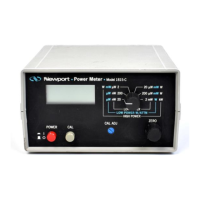8
Table 5 — Calibration Factor Exponent; SETUP DIP Position 3
Calibration Factor Exponent −2 −1 +0 +1 +2 +3 +4
Low-Power 0
†
011
‡
NA NA NA
Low-Power with Attenuator NA NA NA 0
†
011
‡
High-Power NA NA NA 0
†
011
‡
†
Divide the mantissa by 10 and re-enter. Example: 9.00E−2 becomes 0.90E−1. Now
0.90 is the mantissa and −1 is the exponent.
‡
Multiply the mantissa by 10 and re-enter. Example 1.50E+4 becomes 15.00E+3. Now
15.00 is the mantissa and +3 is the exponent.
2.4.5 Detector Acceleration Time Constant
NOTE
Accelerator circuit will increase the noise floor level.
The Model 1815-C uses an acceleration circuit to electronically shorten the
risetime of Newport’s High-Power disk thermopile detectors. This is done
when SETUP switch position 4 is set to “1”. A back panel potentiometer,
ACCEL ADJ, is used to adjust the time constant of the acceleration circuit to
match the time constant of the detector. Since most of Newport’s High-Power
detectors have approximately a 1 second time constant, the ACCEL ADJ
potentiometer is adjusted at the factory for this value. However, because the
actual time constant is not exactly 1 second for all the smaller thermopiles, it
may be required to optimize the acceleration.
You can set or fine tune the ACCEL ADJ to your particular detector. This is
especially useful if you are monitoring the processed analog output on an
oscilloscope or other time based or data logging instrument. This adjustment
is required if you are using a High-Power detector that does not have a 1 sec.
time constant. When the ACCEL ADJ setting does not match the actual time
constant of the attached detector, you will see some overshoot or undershoot
on the processed analog output signal. To fine tune the ACCEL ADJ potenti-
ometer use the following procedure:
1. Set the SETUP DIP switch positions 1, 2, 3 and 4 to “0, 1, X, 1”. Con-
nect your High-Power detector and monitor the analog output on an
oscilloscope.
2. Introduce a step function of optical power to the High-Power detector.
You should observe a signal trace similar to Figure 5.
3. Adjust the ACCEL ADJ potentiometer until the overshoot or undershoot
of the analog output signal is eliminated.

